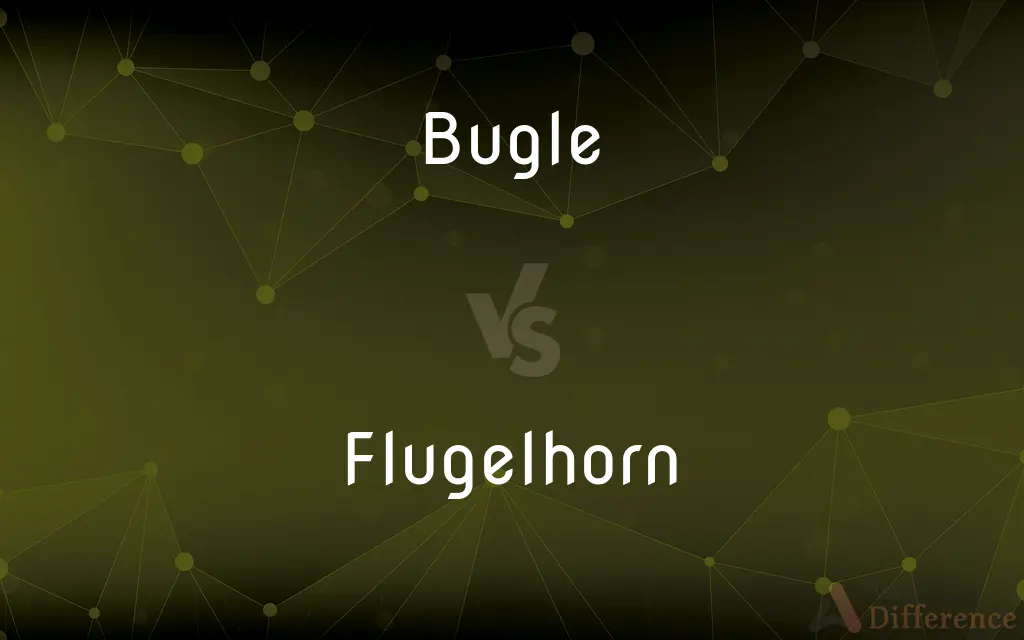Bugle vs. Flugelhorn — What's the Difference?
By Tayyaba Rehman & Maham Liaqat — Updated on May 3, 2024
Bugles are simple brass instruments with no valves, used for military signals, while flugelhorns, resembling trumpets, have valves for chromatic play.

Difference Between Bugle and Flugelhorn
Table of Contents
ADVERTISEMENT
Key Differences
Bugles are known for their simplicity, consisting of a coiled tube with a conical bore and a flared bell but no valves, facilitating basic pitch changes through lip tension. Whereas flugelhorns, with their valves and more complex design, allow for a full chromatic scale, making them versatile in various music genres.
Bugles typically produce a limited range of notes, which historically made them ideal for military and ceremonial use where simple, clear signals were necessary. On the other hand, flugelhorns offer a wider range of notes and a deeper, mellower sound, suitable for jazz, brass bands, and orchestral settings.
The shape of a bugle is generally more straightforward and shorter than a flugelhorn, which affects the instrument's tonal quality and projection. Whereas the flugelhorn features a more elongated shape with a conical bore that extends throughout its length, contributing to its unique sound.
In terms of playability, the bugle is often used as a training instrument for beginners, particularly in military and scouting organizations, because of its simplicity. On the other hand, the flugelhorn requires more skill to manage its three valves and the subtleties of its sound production.
Bugles are less common in contemporary music and are mostly found in traditional and military contexts. Whereas flugelhorns have been embraced by modern musicians, particularly in jazz, where artists like Miles Davis have popularized their soft, velvety tones.
ADVERTISEMENT
Comparison Chart
Valves
None
Three valves
Musical Range
Limited, natural overtones
Wide, chromatic scale
Sound Character
Bright, piercing
Soft, mellow
Typical Use
Military signals, ceremonies
Jazz, orchestras, brass bands
Player Skill Level
Beginner-friendly
Requires intermediate skill
Compare with Definitions
Bugle
Historically, a signal horn made from the horn of an animal.
Ancient bugles were often made from animal horns.
Flugelhorn
A brass instrument resembling a trumpet but with a wider, conical bore.
He played a soothing melody on his flugelhorn.
Bugle
An old term for a bead of tubular shape used in decorating.
The dress was adorned with golden bugles.
Flugelhorn
Requires the use of three valves to alter the pitch.
She practiced scales on her flugelhorn, mastering the valves.
Bugle
Used metaphorically to denote a call to action.
The article sounded a bugle call for environmental awareness.
Flugelhorn
Known for its use in jazz and brass band music.
The flugelhorn added a rich layer to the jazz ensemble.
Bugle
A plant species with blue flowers, common in gardens.
The garden was lined with the blue flowers of the bugle plant.
Flugelhorn
Often used in orchestras to provide a mellower alternative to the trumpet.
The orchestra's flugelhorn section highlighted the adagio movement.
Bugle
A simple brass wind instrument without valves, used for making military signals.
The bugle's call at dawn is a military tradition.
Flugelhorn
Prized for its velvety sound texture.
The flugelhorn's velvety sound soothed the audience.
Bugle
The bugle is one of the simplest brass instruments, normally having no valves or other pitch-altering devices. All pitch control is done by varying the player's embouchure.
Flugelhorn
The flugelhorn (), also spelled fluegelhorn, flugel horn, or flügelhorn, is a brass instrument that resembles the trumpet and cornet but has a wider, more conical bore. Like trumpets and cornets, most flugelhorns are pitched in B♭ (some are in C).
Bugle
(Music) A brass instrument somewhat shorter than a trumpet and lacking keys or valves.
Flugelhorn
A bugle with valves, similar to the cornet but having a wider bore.
Bugle
The loud resonant call of an animal, especially a male elk during rutting season.
Flugelhorn
A brass instrument resembling a cornet but with a wider, conical bore, and usually with three valves, in the same B-flat pitch as many trumpets and cornets but with a more deeply conical mouthpiece than those. A bugle with valves.
Bugle
A tubular glass or plastic bead that is used to trim clothing.
Flugelhorn
A brass wind instrument resembling a cornet but with a wider bore, and having three valves.
Bugle
Any of several creeping Old World herbs of the genus Ajuga in the mint family, having opposite leaves, square stems, and terminal spikes of purplish to white flowers. Also called bugleweed.
Flugelhorn
A brass instrument resembling a cornet but with a wider bore
Bugle
(Music) To sound a bugle.
Bugle
To produce a loud resonant call, as of a rutting male elk.
Bugle
A horn used by hunters.
Bugle
A simple brass instrument consisting of a horn with no valves, playing only pitches in its harmonic series
Bugle
Anything shaped like a bugle, round or conical and having a bell on one end.
Bugle
The sound of something that bugles.
The bugle of an elk
Bugle
A sort of wild ox; a buffalo.
Bugle
A tubular glass or plastic bead sewn onto clothes as a decorative trim
Bugle
A plant in the family Lamiaceae grown as a ground cover Ajuga reptans, and other plants in the genus Ajuga.
Bugle
To announce, sing, or cry in the manner of a musical bugle.
Bugle
(obsolete) jet-black
Bugle
A sort of wild ox; a buffalo.
Bugle
A horn used by hunters.
Bugle
A copper instrument of the horn quality of tone, shorter and more conical that the trumpet, sometimes keyed; formerly much used in military bands, very rarely in the orchestra; now superseded by the cornet; - called also the Kent bugle.
Bugle
An elongated glass bead, of various colors, though commonly black.
Bugle
A plant of the genus Ajuga of the Mint family, a native of the Old World.
Bugle
Jet black.
Bugle
A brass instrument without valves; used for military calls and fanfares
Bugle
Any of various low-growing annual or perennial evergreen herbs native to Eurasia; used for ground cover
Bugle
A tubular glass or plastic bead sewn onto clothing for decoration
Bugle
Play on a bugle
Common Curiosities
Is the bugle still used today?
Yes, it is primarily used in military, scouting, and certain ceremonial contexts.
What is the main difference between a bugle and a flugelhorn?
The main difference is that a bugle has no valves and offers a limited pitch range, while a flugelhorn has valves that enable a full chromatic scale.
How does the sound of a flugelhorn differ from a trumpet?
The flugelhorn produces a softer, mellower sound compared to the brighter, more piercing sound of a trumpet.
Are bugles easy to learn to play?
Yes, due to their simple design without valves, bugles are easier to learn compared to other brass instruments.
Can children play the flugelhorn?
Yes, but it may require some basic brass playing skills and physical handling appropriate for older children.
Why is the flugelhorn popular in jazz music?
Its soft, mellow sound blends well with the intimate and expressive nature of jazz music.
What roles does the flugelhorn play in a brass band?
It often plays a role similar to the cornet, providing harmony and filling the ensemble sound.
What genres of music incorporate the bugle?
Mainly military and traditional ceremonial music.
Can you play melodies on a bugle?
Melodies on a bugle are limited to the natural harmonic series of the instrument due to lack of valves.
Do professional orchestras use flugelhorns?
Yes, though less frequently than in bands; it is used for specific sounds and effects.
Is the flugelhorn louder than the bugle?
No, the flugelhorn is generally softer and mellower than the bright, piercing sound of the bugle.
What materials are flugelhorns made from?
Flugelhorns are typically made from brass, but like other brass instruments, can also feature silver or gold plating.
How is the flugelhorn held while playing?
Similar to a trumpet, with the left hand operating the valves and the right hand supporting the instrument.
How do performers alter pitches on a bugle?
Pitches are altered by changing the embouchure, or lip position and tension.
What kind of music is difficult to perform on a bugle?
Any music that requires a full chromatic scale, which is impossible on a standard bugle.
Share Your Discovery

Previous Comparison
Relay vs. Rely
Next Comparison
Countenance vs. TolerateAuthor Spotlight
Written by
Tayyaba RehmanTayyaba Rehman is a distinguished writer, currently serving as a primary contributor to askdifference.com. As a researcher in semantics and etymology, Tayyaba's passion for the complexity of languages and their distinctions has found a perfect home on the platform. Tayyaba delves into the intricacies of language, distinguishing between commonly confused words and phrases, thereby providing clarity for readers worldwide.
Co-written by
Maham Liaqat















































